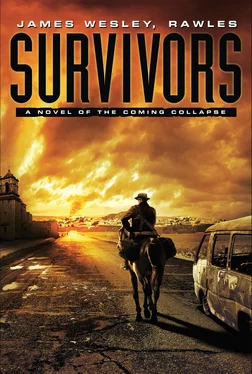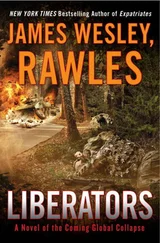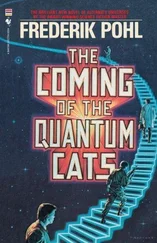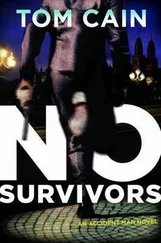Andy switched the transceiver to 10.128. This was prearranged as the primary contact frequency for the Laine brothers. His notepad included a list of alternate frequencies, to use in descending order, in case of interference.
At 0330 GMT (9:30 p.m. in New Mexico), Andy heard a weak Morse code signal: “K5CLB DE K5CLA, K5CLB DE K5CLA” The transceiver’s signal strength indicator barely lit up. That did not bode well, since Lars had a 200 watt transmitter.
Andy reached for the paddles and replied, “K5CLA DE K5CLB KN”
Lars repeated his “K5CLB DE K5CLA, K5CLB DE K5CLA” transmission.
Again Andy replied, but it was apparent that his transmission was not propagating with enough strength to be heard above the static noise floor. After ten minutes of this frustration, Andy heard:
K5CLA DE K5CLB BT
IN CASE U CAN HEAR ME BT
ALL IS WELL WITH US AND KAYLEE BT
LOCAL POWER IS UP BUT US GRIDS DOWN BT
SITUATION LOOKING VERY MAD MAX ALL OVER THE US BT
KL SAYS LUV ES 88 ES HURRY HOME BT
PSALM 91 TO U AR DE K5CLB SK
After three more attempts to make contact, Lars repeated the same brief report and then signed off.
Disgusted at his lack of success at two-way communication, Andy packed up his transceiver in the zipper bags. Realizing that he probably wouldn’t be able to get back to sleep, he moved his ground pad and bivy bag closer to the stump and, being careful not to snag the antenna lead, he crawled in, cradling the shortwave receiver in his left arm.
Andy tuned through several bands, searching for English broadcasts. He caught a brief news summary on BBC at 0430 and a more lengthy news show on Radio Netherlands at 0500.
None of the news was good. The disruption in civilian air traffic in Europe was expected to continue for at least several weeks. Yesterday there had been a simultaneous pair of bombings by al Qaeda in Bonn and Frankfurt. Hundreds of Arab immigrants were rioting over the currency inflation. In Paris and several other large cities in France, they were back to their old tricks: torching dozens of parked cars. Meanwhile, New York City, Baltimore, Chicago, Dallas, and “Loss Angie-Lees” were in flames.
“Whole nations depend on technology. Stop the wheels for two days and you’d have riots. No place is more than two meals from a revolution. Think of Los Angeles or New York with no electricity. Or a longer view, fertilizer plants stop. Or a longer view yet, no new technology for ten years. What happens to our standard of living? Yet the damned fools won’t pay ten minutes’ attention a day to science and technology. How many people know what they’re doing? Where do these carpets come from? The clothes you’re wearing? What do carburetors do? Where do sesame seeds come from? Do you know? Does one voter out of thirty? They won’t spend ten minutes a day thinking about the technology that keeps them alive.”
— Larry Niven and Jerry Pournelle,
Lucifer’s Hammer (1977)
Bloomfield, New Mexico November, the First Year
The collapse of the power grids was a turning point in the Crunch. Before the grid went down, life in the U.S. went on with just the stress of mass inflation. But after grid power disappeared, life changed radically. The Texas grid was the last one to go, just a few days after the eastern and western grids failed in rapid succession.
The cities of Farmington and Bloomfield had power supplied by the Farmington Electric Utility System (FEUS), a local power co-op that had its own production capacity from three natural-gas-fired plants, as well as a hydroelectric plant at the Navajo Dam, on the San Juan River. These provided nearly all of the power needs for their 1,700-square-mile service area. The remainder of their power was purchased from the western grid at wholesale rates. When the western grid collapsed, the FEUS was able to get local power-detached from the main grid-back online within a minute. If it were not for this local production capacity, the cities of the Four Corners region, as well as many farmers and ranchers, would have run out of water. Meanwhile, most other cities in the nation only had a three-day supply of water in the gravity tanks that provided pressure to the municipal lines. When the grid went down, the municipal water systems in those cities failed.
Robie Laine had carefully researched and chosen Bloomfield for relocation, primarily because of its local power generation capacity and agriculture. The communities’ growth in the 1980s and 1990s eventually outstripped the local power production capacity of FEUS. However, by removing daytime service to some industrial customers and begging the local community to take extreme conservation measures-by asking customers to refrain from using electric heaters and to not use electric kitchen ranges during daylight hours-the utility was able to meet local needs. The local public relations ad campaign emphasized: “Save power, so we’ll have water, and save water, so we’ll have power.” That message was heeded by most customers and power consumption dropped by 20 percent.
The other reason that Robie Laine had picked the Bloomfield area was that the region was served by a number of irrigation ditches that ran year-round. These were entirely gravity-fed as diversions from the San Juan River, far upstream to the east. The ditches north of the river were administered by the Bloomfield Irrigation District (BID) and ditches south of the river by the Hammond Ditch Association. The maze of ditches included the Porter Ditch, Citizen’s Ditch, Jacquez Ditch, and the Pumpa De La Sequia. Thanks to fairly reliable rains that kept the Navajo Dam full, and seasonal releases from the dam, the irrigation ditches never went dry.
Throughout the United States, EPA water quality standards instituted in the 1980s and 1990s forced even cities with gravity-fed water systems to install electric pumps for water filtration. Older gravity filters were replaced with new filters that met the 0.3 nephelometer turbidity unit (NTU) standard filters. In most cases, this meant that new filters that were pressurized with electric pumps had to be installed. When the grids went down, many city water utility engineers were reluctant to bypass the pressurized water filtration systems for fear of being fined by the EPA. So people who otherwise would have gravity-fed drinking water available were no better off than those who lived where electrically pumped water from aquifers was the norm. This needlessly turned millions of additional people into refugees.
The San Juan Generating Station, on Navajo tribal land fifteen miles west of Farmington, near the town of Fruitland, was a coal-fired plant with four operating units that together could produce 2,000 megawatts of power, making it one of the biggest coal-fired generating stations in North America. After the western grid failed, the plant’s managers took the plant offline. For the grid to function, nearly all of its production units had to be online: it was essentially an “all or nothing” grid, and the catastrophic grid failure of the Crunch was something that had never been fully anticipated.
In normal operation, the San Juan Generating Station consumed 15,000 tons of coal per day. The plant was the first of several western “mine-mouth” co-located power plants that drew from contiguous deposits of sub-bituminous coal. Much of the coal came directly to the plant by way of a 2,800-yard-long conveyor belt system.
By itself, San Juan could not serve the entire western grid. Efforts to reconstitute the grid were almost comical. Only the hydroelectric plants of the Pacific Northwest and a couple of mine-mouth plants like San Juan stayed online during the reconstitution attempts. All of the smaller plants were off-line, mostly due to lack of workers, many of whom were striking in an attempt to get inflation indexing of their salaries. The nuclear plants all went off-line. Frustratingly, the Nuclear Regulatory Commission refused to recertify the plants for operation unless a three-day checklist restart procedure with umpteen inspections was strictly followed.
Читать дальше












